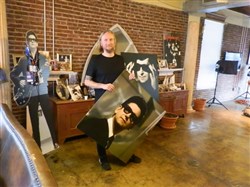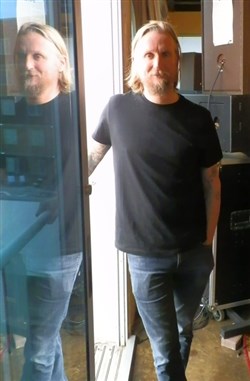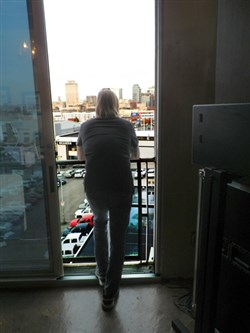VOL. 40 | NO. 51 | Friday, December 16, 2016
Legendary Orbison poised for posthumus comeback

Alex Orbison carries a couple of the portraits of his iconic father, Roy Orbison, inside the Roy’s Boys offices on Broadway.
-- Tim Ghianni | The Ledger“Dum-dum-dum-dumdy-doo-wah ….” Probably not a pretty sound, but that’s what I was singing – “Only the Lonely” – when I pulled my ancient Saab into a visitor’s spot in the parking lot outside the building named for Nashville’s most-celebrated rock star, a kind man with a voice that soared from baritone to tenor as he sang of heartache, loss and, very seldom, life’s triumphs.
I’d been “singing” Roy Orbison songs all the way down to the Orbison Building at 1625 Broadway, where he is being prepped for what could be his most successful two years in the entertainment business.
There is one big stumbling block. He’s been dead since December 6, 1988, victim of a heart attack after enjoying his passion for flying remote-controlled airplanes in his mother’s Hendersonville yard.
His career has had its peaks and valleys. The death 28 years ago was probably the biggest valley – even though, at least for a few days, it did bring the man, who some musically illiterate thought was a blind albino – and his music back to TV and radio airwaves, at least for a bit.
His “baby” son Alex, now 41, who I had come to visit on this afternoon, says Roy didn’t mind some idiots thought he was a blind albino – a misconception based on his ever-present sunglasses and his pale complexion (musicians work nights, you know … there are a lot of pale people in Nashville).
All he cared about was that people listen to his soaring, oft-melancholy songs, the stuff he’d been singing since 1956 when he left behind his rural Texas roots and rockabilly band and became a Sun Records artist.
Memphis’ Sun, I hope you know, was the cauldron in which much of what we call rock ’n’ roll was concocted by mad-scientist producer Sam Phillips. Other artists launched there had names like Elvis, Jerry Lee, Cash, Carl Perkins. (It should be noted that Roy had plenty of reason for his trademark musical melancholy: Two of his sons from his first marriage died in a Hendersonville house fire in 1968, about two years after his first wife, Claudette, died in Roy’s arms after a motorcycle wreck just as the couple began a motorcycle holiday. A side note: Roy’s love of motorcycles was ignited by his great pal Elvis Presley).
Alex and his sounding board – brothers Roy Jr. and Wesley – and members of the Roy’s Boys staff are stealthily executing Roy’s latest “comeback” on the sixth floor of this luxurious/industrial space where the singer’s spirit not only lives … it’s damn hard to get out of eyeshot of at least one stunning portrait of Vernon, Texas’ most-famous export.
“Roy’s going to be at a fever pitch in 2017,” says Alex as he relaxes – and often consults his smart phone to double-check his facts – while detailing the plans for that banner year … and the one after that.
Sometimes he refers to the owner of rock ’n’ roll’s most-flexible voice as “father or dad….” Other times – like when he’s talking about fresh “product” that’s begun appearing in the marketplace – he calls the singer “Roy.”
There’s always admiration in his voice no matter how he refers to the iconic singer who pretty much finished his mortal career as a member of rock’s most-celebrated 1980s super group.
Under the pseudonym of Lefty Wilbury, he made magical music with his Traveling Wilburys’ mates: Band founder Nelson Wilbury (George Harrison, the so-called “Quiet Beatle”), Otis Wilbury (ELO’s Jeff Lynne), Charlie T. Wilbury Jr. (Tom Petty) and Lucky Wilbury (illusive Nobel Prize winner Bob Dylan.)
While Alex does the talking and much of the planning, he emphasizes the collaboration of his brothers.
“With three brothers working together, we’ve got a pretty good system of checks and balances in place,” this much-tattooed former indie rock drummer says as we settle into chairs at the table where the brothers (and confidantes) plot strategy for world domination by their long-dead pop.
Well, I overstate a bit. They truly are aiming for the next two years to be huge at the box office, on television and on recorded music, all in celebration of their father’s unmatchable voice.
Roy – I can call him that as he was a hero to this somewhat damaged survivor of the Baby Boom who sang, line- for-line, front-to-back, The Traveling Wilburys’ first album in 1988-89 while commuting from Nashville to Clarksville – would be proud of what’s being hatched on the sixth floor of the Orbison Building.
Alex and his brothers know that to some Roy has basically disappeared, at least in the minds of people whose lives don’t stretch back to the day in 1988 when he died after enjoying his mini-airplane passion.
“He was a model airplane enthusiast,” Alex says, noting Roy and his bus driver and pal Benny Birchfield – who was Opry legend Jean Shepard’s husband – shared that remote-control aircraft fanaticism whenever they had some spare time and an open field.
“Roy knew that every artist has an ebb and a flow. There are really hot points, and then there are slack times,” Alex adds.
Right now, besides being dead, Roy is in something of a career lull. The most-recent big career high point was in the deep past, when his voice soared alongside Dylan, Petty, Harrison and Lynne.
That also pretty much coincided to the time his classic “In Dreams” was used as one of the many obsessions of Dennis Hopper’s crazed character in David Lynch’s very dark 1986 cult classic movie, “Blue Velvet.’’
That sprung enough interest that Roy rerecorded that song and a bunch of his other classics in a new, hit album, “In Dreams: The Greatest Hits,” released in 1987.
Then came what Alex refers to as “the greatest concert ever:” – “Roy Orbison and Friends, A Black & White Night Live” (with co-conspirators including Springsteen, Jackson Browne, Costello and so many others, backed by his old pal Elvis’ TCB Band, led by James Burton.)
Roy, the human being, did see “Black & White” when it was broadcast on Cinemax not long before his death. He wasn’t around for the worldwide and much-celebrated audio/video release of the concert.
Nor was he around in 1990 when Julia Roberts steamed it up with Richard Gere in “Pretty Woman” – which used that Orbison classic as its theme song.
When Lefty Wilbury reached the end of the line, everyone knew who Roy Orbison was, which was mighty good medicine for the singer in his final years.
“He became really sad in 1978,” Alex points out. “He had had his first heart attack and Elvis had died. Dad was heartsick. That’s when it helped that the Traveling Wilburys (and the other projects) came along.”
For many years, his widow, Barbara, a pretty woman, indeed, was the keeper of the flame, trying to keep the Orbison brand out there. But in 2011 – after a brief bout with pancreatic cancer – she died at the Orbison estate, atop a cliff in Malibu.

Alex Orbison takes time to reflect – both literally and figuratively – while standing near the wall of windows on the sixth floor of the Orbison Building.
-- Tim Ghianni | The LedgerHer own work to keep Roy at the top of pop culture was not finished when she died, and the mission of carrying forward The Big O fell to his sons.
“I started doing it because I had been checking on my mom every day, making sure the doctors were taking care of her,” says Alex, softly, while fiddling with his cell phone.
“Mom passed away on a Tuesday. I had to plan the funeral. Sunday was taken at the funeral home, so I had to plan to have it all set for Saturday.
“Then I had one day off, Sunday. Then I came here.
“I came here because if someone wasn’t around… well, I needed to be here to make sure the transition was smooth.” He knew his mom’s vision. He knew his dad’s voice. And he knew there were plenty of great opportunities to come.
“On one side I lost my mom, who raised me. On the other half, I lost Barbara who was very crazy,” he says, with a laugh. He uses the term in tones of admiration, as that craziness is what kept the Orbison brand alive all those years.
“She had such a spunk. She was such a force. Even when she was dying, she was talking about living life in the moment.”
It wasn’t easy to take his mom’s place. First, of course, he had to fend off the “barrage of banks, insurance and real estate brokers and attorneys.”
It was then that he pretty much got a full realization of what a treasure his father’s music was and why his mom devoted her own life to keeping it flourishing.
“I really hadn’t had a lot to do with Roy’s music, I had mostly been with Still Working Music,” the publishing end of the Orbison empire, housed on the second floor of this building.
With his forced-by-trauma education, he began to believe that for his dad’s legacy, well, the best years were yet to come.
“I’m like my mom in that if something’s cooking, I can smell it,” he says, adding his pop is “pistol hot …. And things are just beginning to heat up.”
Like his dad, Alex is a gentle man and likes to let Roy’s voice carry the load.
Like his mom, he is a shrewd, self-educated businessperson who pushes the Orbison brand forward.
Those were just some of the things I wanted to talk about when I called Alex a few weeks ago and asked if he’d do an interview about his dad’s pending massive resurgence.
There was a little taste of the “comeback” with the 2015 release of an “undiscovered” album by Roy “One of the Lonely Ones.” It was just a taste of what was still to come.
Alex is a laid-back fellow, so it wasn’t hard to get in touch with him. What was difficult was finding a window in his schedule which right now has him immersed in a full-fledged documentary about his dad.
For example, one day didn’t work out because “Bruce is supposed to call. When he does, I’ll need to get to New York,’’ he said, noting Springsteen is one of the admirers who appear in the documentary.
I stepped aside for The Boss (I don’t know if he’d do the same for me), but Alex and I arranged to meet later.
“Later” came just two days after the fifth anniversary of his mom’s death and the 28th anniversary of Roy’s.
Finally, I made it up to the sixth floor of the Orbison building, a floor that is occupied primarily by Barbara’s old office, the comfy furniture and the massive conference table.

Alex Orbison is silhouetted by “mom’s million-dollar view” as he stands by an open sliding door near his mother’s old desk.
-- Tim Ghianni | The LedgerOh, yeah, and then there are the pictures of Roy – paintings, photos, whatever – occupying much of the wall space. Someplace on the walls in this building where Roy’s spirit still thrives there is a framed copy of a Sunday profile piece I wrote about Barbara when I worked for the morning newspaper here in town.
I’d spent a day with her at her grand old mansion on Estes in Green Hills, and my story was just to let people know what this brilliant businesswoman was like.
I wrote that piece to a mental soundtrack of “Only the Lonely,” “Crying,” “Pretty Woman,” and the seemingly countless Roy classics.
Oh, and the headline was “Baby, She’s Got It” – a reference to one of Roy’s classic love songs, “You Got it”: “Anything you want, you got it/Anything you need, you got it/ Anything at all, you got it ….Baby…..”
I was charmed by her, and the story must have turned out better than she expected, as the day after it was published she had 10 dozen red roses delivered to me at the newspaper office.
“Look over there. That’s my mother’s million-dollar view,” Alex says of the wall of windows that offers perhaps the best (albeit hazy) look at the Nashville Skyline since Orbison’s pal Dylan used that as the cover and title of a classic album made on Music Row. The Nobel-winner’s view, of course, was long before “It City” cranes and condos took over.
The true new sizzle for Roy Orbison was lighted this fall, with the release of a career-spanning single-disc anthology – “The Ultimate Collection” – a dandy holiday gift for anyone who’d enjoy the purest and most-flexible voice ever to hit Nashville.
“We wanted to put this out so people could get a real sense of his career,” Alex adds. Yes, there are boxed sets to be had. But “this greatest hits is like the cement toward what we are throwing down, to have a go-to hits package.”
The fast-paced 20-song CD (or double-LP) is designed to not only satisfy fans but to entice more by quickly running through a score of songs like I’ve mentioned earlier.
And, as a bonus, this is the first Roy album to also include “Not Alone Any More” and “Handle with Care,” two of the Wilburys’ best songs.
“‘Handle with Care’ is important to this collection because that was the last actual hit my dad had,” Alex explains.
“We talked to Olivia Harrison (widow of Nelson Wilbury, the band-leader who once was a Beatle named George) and she was really good about it.”
Coming next is a basically new version of “Black & White Night.”
“We re-cut it, we re-did it and we put it in its original sequence; so now, when you watch it, it is more like a concert and less like a TV Show.
“Can’t knock the original ‘Black & White Night,’” Alex says. “It was the best concert of all time. But there is an interesting fresh, new but familiar feel to this.”
He explains his motivation.
“Basically, when your dad dies when he’s only 52 and my mom didn’t make it to 61 …. It makes you know you need to do what you want with your life. Life’s too short.”
His mission is to keep his father’s voice, his mother’s business thriving for years to come. “We’ve got a five-year plan … after that we’ll have a new five-year plan,” Alex says.
A coffee-table book will be released at summer’s end. There is a Broadway-style musical in the works that’s not about Roy and his life, but which uses only Roy songs.
The “cherry on top,” Alex adds, is the big-screen biopic that will come out toward the end of 2018.
“Then there’s also a top-secret project I can’t tell you about. All I can say is it’s from Sony.”
The simple explanation for all this activity? “We want people to get to know Roy.”
If you don’t “know Roy,” “The Ultimate Collection’ will leave you dumbstruck.
“If anything, his voice had gotten better,” Alex says. “He took the music to new places. His voice was more thunderous in the ‘80s.
“People realized he was one of the best bets in live performance. Buy a ticket and he would blow you away.”
Then he laughs. His dad is long gone, but “2017 and 2018 could be a great meteoric run” for Roy Orbison.
“At the end of the day you only have to be as good as Roy is,” says Alex as he escorts me to the parking lot outside the Orbison Building. “Dad always did things 100 percent.”
“Dum, dum, dum, dumby do-wah….,” I sing as I nurse the old car out into Broadway rush-hour traffic.
“Ooh, yay, yay, yay, yeah….”